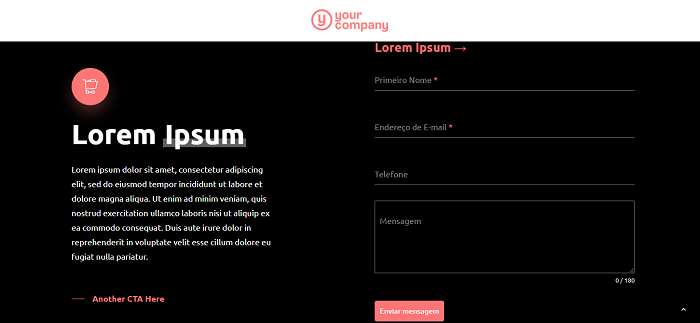
Regardless of the segment or size of the company, the lead generation is of paramount importance for acquiring new customers, increasing revenue and expanding the business. In this respect, a well-founded Landing Page that follows good practices is crucial to maximizing results.
Check out this article on what it is, what it's for, the main elements of a successful Landing Page and other topics with the potential to improve the lead capture process.
What is a Landing Page?
A Landing Page is a page that aims to generate conversions by collecting information from the user: so-called lead capture.
In short, a Landing Page has elements that make it possible to collect leads, usually by filling in forms (name, contact, e-mail, etc.).
They can only be dedicated to the user who wants to find out more about the product or service, or even schedule a demonstration. On the other hand, they can also offer infographics, spreadsheets, e-books and other materials as a benefit to the user.
In addition, depending on the business, some qualifying questions are inserted, such as:
- Position;
- Number of Employees;
- Educational level;
- Investment in marketing;
- Among others.
Here's an example of a Landing Page template that was used by some of our clients during Black Friday.
This Landing Page is a solution offered by Paretoa product called Pareto Pages that allows creation and customization according to customer demand.
The main focus of the Landing Pages developed by Pareto is to increase the conversion rate based on the best practices for capturing leads.
In general, during promotional periods such as Black Friday, many companies seek to capture leads by providing more information about products, exclusive discounts, purchase advantages, etc.


What is a Landing Page for?
A Landing Page is intended to be a destination for marketing actions aimed at acquiring leads so that your sales team can convert them into new customers, i.e. the focus is on obtaining business opportunities.
They can also be focused on offering advantages in E-commerces, as we saw in the previous example. In this case, the customer can be impacted with actions and discounts that encourage them to close the purchase.
To do this, they aim to present some information that will interest the visitor, so that in return they can send their contact information.
Want to find out more about marketing solutions for E-commerce? Read our article on Automation for E-commerce.
What's the Difference Between a Landing Page and a Website?
With regard to the main differences between a Landing Page and a website, while a website's function is to be more informative and offer content to visitors, a Landing Page has a content that is more geared towards converting leads.
One widely used strategy, for example, is to insert a call to action on the site directing to a specific Landing Page. This captures organic or paid searches that have qualified and are ready for a more commercial and direct tone.
Another item that differentiates them is the direction of the visitor's attention. While on the website the user can have several different visual stimuli and can cover different pages, on the Landing Page all the resources are directed towards the user making the conversion.
The Importance of the Landing Page for Marketing Strategy
Not only are Landing Pages very important for capturing leads, but if used correctly, they can also be used to carry out various analyses with the potential to develop your business even further. Here are some of the options.
Facilitates Lead Scoring Actions
O Lead Scoring is a way of prioritizing the leads that are most qualified within your strategy. This process takes place by means of scores that are assigned to the leads using certain criteria based on the information sent by the leads.
For example, in a B2B company, a lead who fills in the Landing Page form with a corporate email tends to be more qualified than a lead who fills it in with their personal email. Therefore, the former will receive a higher qualification score.
With this, the work of your sales team becomes increasingly assertive, optimizing conversions and making better use of opportunities. You can also build a good relationship with your contacts by sharing marketing content and valuable information. Email marketing is widely used in these actions.
To do this, you need to have a Landing Page designed to better qualify these leads. This way, you can define the content that makes the most sense within your business for each lead.
Segment contacts and leads
From the moment you reach a level of clarity and objectivity about what the lead's conversion is in a given material or stage of the funnel, you can better segment your potential customers.
This is of the utmost importance when working with more than one product/service and with more than one defined persona, as it is possible to distinguish these personas through conversion on the Landing Page.
It is also possible to classify leads in different stages of the marketing funnel - Top, Middle and Bottom of the Funnel - adapting communication to each of them.
Decreases CAC (Customer Acquisition Cost)
One of the main advantages of using Landing Pages is that they are an option for increasing the generation of opportunities for your business. This is because they will be points focused on conversion, and can considerably increase leads from all sources (organic and paid) if well planned.
Often, by offering free material, you can get leads at a much lower cost than if you just sent out contact forms on the website. They also increase brand awareness.
Thus, with good promotion and strategy, a Landing Page can be responsible for a large part of capturing leads, generating plenty of opportunities for the sales team.
What are the Main Elements of a Landing Page?
Now you know what Landing Pages are and their importance. So, the next step in using a Landing Page to optimize conversion and bring good results is to understand some elements that are indispensable in its construction.
Title and Subtitle
This is a fundamental stage in the strategic approach, since it is of the utmost importance to clearly communicate what is on offer. Aiming to arouse visitors' interest so that they don't feel misled.
The first step is to come up with a catchy, simple, understandable title that is in line with your offer. In addition, it's important to make it clear what kind of content people will find when they fill in the form: whether it will be an ebook, newsletter or consultancy, for example.it will be an ebook, a newsletter or a consultancy, for example.
For the subtitle, a good practice is to add a short description of what will be delivered. According to data released by Copyblogger8 out of 10 people who arrive at a page only read the headline.
In other words, we realize that the main elements of a page are the title and subtitle. That's why you should use all your creativity to create irresistible titles and subtitles for your Landing Pages.
Image
Creatives have the role of generating interest and drawing the reader's attention to encourage them to purchase the material offered by your business strategy. You should therefore choose high-quality images that make sense for the material being offered.
If there is no one on your team with experience in image editing, sites such as Trakto e Canva can help you create and personalize your images more easily.
Offer
No matter how good a Landing Page you've built, people will only fill in forms with their personal information if you generate a value proposition for those who visit that page.
A conversion page needs a few descriptions about the offer in order to sell the idea well, eliminate points of doubt and align expectations.
In some scenarios, where the offer is complex and needs a lot of detail, one of the alternatives is to use explanatory videos or a preview of the material, or with terms in bold, important topics, among others.
CTA (Call to Action)
Another key element is the so-called "Calls to Action" or "CTAs". These calls to action are buttons with text inviting us to take an action, usually with imperative phrases such as: Download now or Sign up now.
Creating an inviting CTA on your Landing Page is essential to ensure that the user takes action on your page. To do this, you should place it in a strategic position and highlight it in a color that matches your LP.
Form
Forms are another very important aspect of a Landing Page. It's therefore crucial to map out all the fields that are really necessary and have the potential to qualify leads, as this information is very relevant for making decisions in your business.
Commonly, the main items are name, contact details and fields about business-related items.
Although the more fields the better to understand more about the lead, don't overdo it with the amount of data the reader has to fill in on your form, as this can be a nuisance if the process is too bureaucratic, reducing the completion rate.
Extra Elements
Other elements you can use in your Landing Pages:
- Sense of urgency: add on the Landing Page how long it is before an offer expires to encourage the undecided visitor to act faster.
- Social proof: Put evidence that other people who have downloaded, bought or found some value in the offer. People tend to access material that has recommendations. Adding testimonials is a way of increasing conversion.
How to Create a Successful Landing Page with Pareto?
O Pareto Pages is a statistics-based Landing Page creation tool from Pareto. Its advantages include conversion-focused templates, agility in creation and high potential for maximizing conversion.
You can choose from a number of plans based on the flow of users on the Landing Page. With this option, you can create your own Landing Pages based on the templates offered and already pre-assembled.
There is also the option for our team of designers to create a customized template, based on the information you provide.
Here are some tips for creating your Landing Page based on the main elements of the page.
Contents
Create the Title and Subtitle of the Landing Page
With regard to the title and subtitle, it is suggested that they show clarity about the type of content people will find on the page.
Write the Landing Page Texts
The texts on the Landing Page must be targeted and explain the product/service on offer, in order to meet the demand for the minimum information needed to convince users to make a decision.
Define Landing Page Images
One of the crucial stages is defining and inserting the images. To do this, it is important to develop a strategy so that the images inserted generate value for the Landing Page, explain the product/service and are of high quality.
Design
Choose a Ready-made Template on the Pareto Page
With Pareto Pages, you have the possibility of selecting a ready-made template from the many present, in order to provide the most suitable templates for your current needs. Then all you have to do is customize certain elements to suit your business.
Add Content
Among the items present in the design process, it is notable that the addition of content should be implemented according to the main information that the visitor needs.
Determine the Form Fields
Defining form fields in Pareto Pages is quite simple, especially when the items have already been predefined.
Customize your identity
It is recommended that the page's identity be customized according to the company's color palette and visual standard. As well as the insertion of logos.
Settings
Configure the URL
The configuration of your URL is of the utmost importance so that by reading it the user can identify its destination as belonging to your company.
Set up the Thank You E-mail
The purpose of setting up the thank you e-mail is to provide a brief thank you and to send materials if agreed.
Create a Thank You Page
The thank you page should be set up with a short text. If valid, add information such as a notice about the sending of complementary material to the e-mail.
Track Conversion Rates
Monitoring the conversion rate is crucial to identifying its performance and, if necessary, implementing some tests by modifying some of the elements that make up its composition.
The use of Landing Pages is intrinsically linked to the possibility of optimizing your marketing and conversion strategies. By using these pages, you increase your conversion potential and improve your customers' perception of you and generate more business at a lower cost.
To find out more about Pareto Pages and to try it out or hire it, just visit our website with details of plans and prices for this service. And if you want a personalized design, request a free demo and our team will present the options for your company.




















